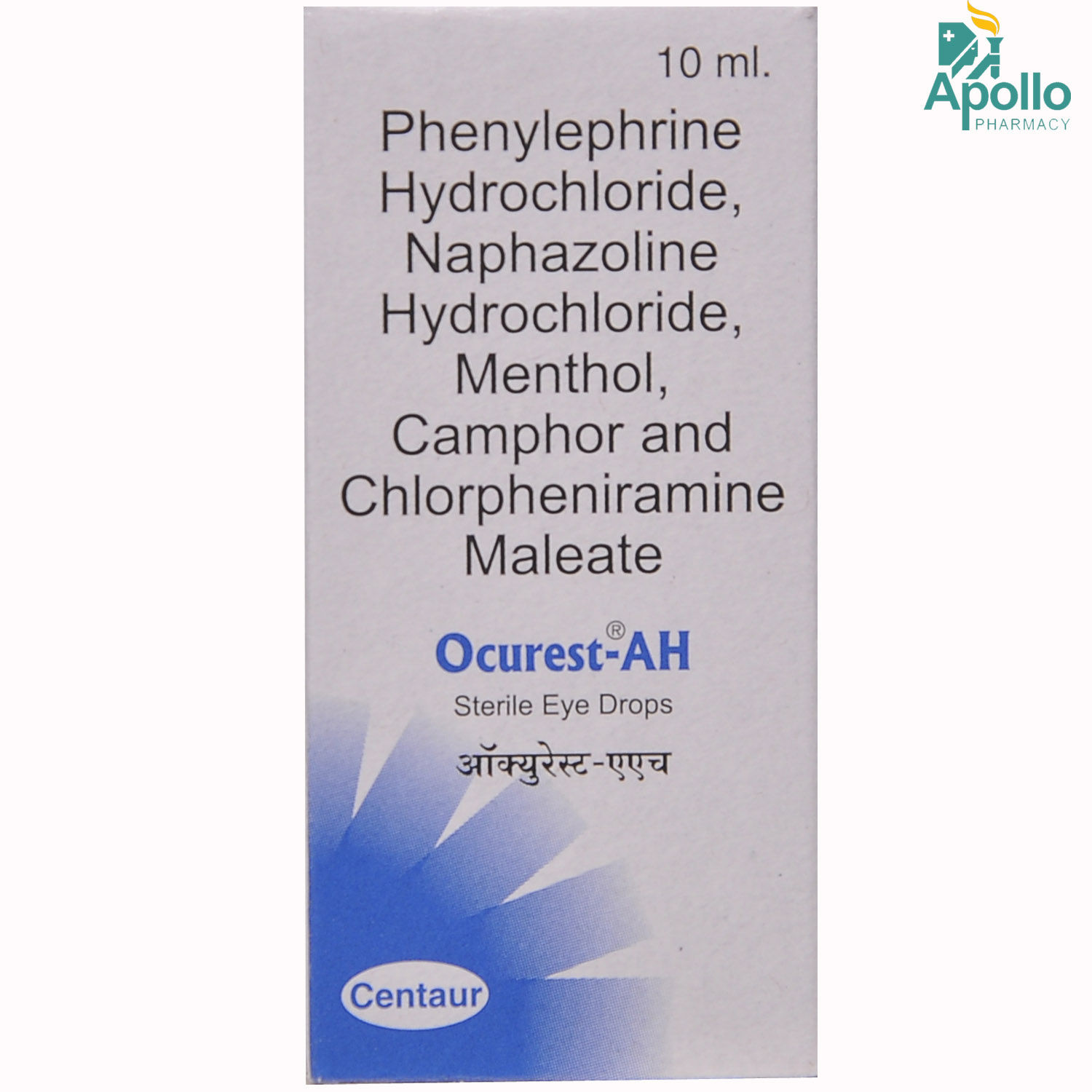Phenylephrine+naphazoline+chlorpheniramine+camphor+menthol
About Phenylephrine+naphazoline+chlorpheniramine+camphor+menthol
Phenylephrine+naphazoline+chlorpheniramine+camphor+menthol is an ophthalmic medicine used to treat allergic conjunctivitis (eye allergy) and computer vision syndrome (digital eye strain). Phenylephrine+naphazoline+chlorpheniramine+camphor+menthol provides relief from watery eyes, redness, itching, burning sensation, discomfort and dryness of the eyes due to exposure to wind, sun, or dust. Allergic conjunctivitis, also known as eye allergy, is the immune response when the eye comes in contact with an irritating substance known as an allergen.
Phenylephrine, Naphazoline, Chlorpheniramine, Camphor, and Menthol are all components of Phenylephrine+naphazoline+chlorpheniramine+camphor+menthol. Decongestants such as phenylephrine and naphazoline constrict or narrow the blood vessels in the eye, which reduces inflammation (redness and swelling). An antiallergic drug called chlorpheniramine maleate prevents the release of particular chemical messengers that cause red, itchy, and watery eyes. Menthol and camphor contribute to the cooling effect on the eye. Together, Phenylephrine+naphazoline+chlorpheniramine+camphor+menthol aids in easing the symptoms of an eye allergy.
Phenylephrine+naphazoline+chlorpheniramine+camphor+menthol is for ophthalmic (eye) use only. Use the dropper provided by the pack to instil the drops into the eye. You are advised to use Phenylephrine+naphazoline+chlorpheniramine+camphor+menthol for as long as your doctor has prescribed it for you, depending on your medical condition. In some cases, you may experience certain common side effects such as pain, irritation, blurred vision and stinging sensation. Most of these side effects do not require medical attention and will resolve gradually over time. However, you are advised to talk to your doctor if you experience these side effects persistently.
Talk to your doctor if the irritation persists despite using Phenylephrine+naphazoline+chlorpheniramine+camphor+menthol for three days or if the condition worsens. Consult your doctor before using the Phenylephrine+naphazoline+chlorpheniramine+camphor+menthol if you are pregnant or breastfeeding. Phenylephrine+naphazoline+chlorpheniramine+camphor+menthol should not be used in children unless prescribed by the doctor. Please do not touch the tip of the dropper, as it may contaminate the contents. Inform your doctor regarding other prescription, non-prescription and herbal medicines you take to prevent any side effects/interactions.
Uses of Phenylephrine+naphazoline+chlorpheniramine+camphor+menthol
Medicinal Benefits
Phenylephrine+naphazoline+chlorpheniramine+camphor+menthol combines five drugs: Phenylephrine, Naphazoline, Chlorpheniramine, Camphor and Menthol. Phenylephrine+naphazoline+chlorpheniramine+camphor+menthol is used to treat allergic conjunctivitis and computer vision syndrome (digital eye strain) associated with watery eyes, itching and redness of the eye. Phenylephrine+naphazoline+chlorpheniramine+camphor+menthol provides relief from redness, itching, burning sensation and discomfort due to the eye's dryness and exposure to wind, sun or dust. Phenylephrine and naphazoline are decongestants that work by constricting or narrowing the eye's blood vessels, and this helps relieve itching and irritation. An antiallergic drug called chlorpheniramine maleate prevents the release of particular chemical messengers that cause red, itchy, and watery eyes. Menthol and camphor contribute to the cooling effect on the eye. Together, Phenylephrine+naphazoline+chlorpheniramine+camphor+menthol aids in easing the symptoms of an eye allergy.
Directions for Use
Storage
Side Effects of Phenylephrine+naphazoline+chlorpheniramine+camphor+menthol
- Pain
- Irritation
- Stinging sensation
- Blurred vision
Patients Concern
Disease/Condition Glossary
Allergic conjunctivitis: Also known as eye allergy, is the immune response that occurs when the eye comes in contact with an irritating substance known as an allergen. Allergens include dust, smoke, dander, mould or pollen. Eye allergy symptoms include itching, burning sensation, watery eyes, red/pink eyes, scaling around the eyes and swollen or puffy eyelids.
Computer vision syndrome: Computer vision syndrome, also known as digital eye strain, is a vision-related problem that occurs due to prolonged computer, tablet and mobile use. Symptoms include blurry vision, dry eyes, eye strain, headache, and shoulder and neck pain.
FAQs
Phenylephrine, Naphazoline, Chlorpheniramine, Camphor, and Menthol are all components of Phenylephrine+naphazoline+chlorpheniramine+camphor+menthol. Decongestants such as phenylephrine and naphazoline constrict or narrow the eye's blood vessels, reducing inflammation (redness and swelling). An antiallergic drug called chlorpheniramine maleate prevents the release of particular chemical messengers that cause red, itchy, and watery eyes. Menthol and camphor contribute to the cooling effect on the eye. Together, Phenylephrine+naphazoline+chlorpheniramine+camphor+menthol aids in easing the symptoms of an eye allergy.
Phenylephrine+naphazoline+chlorpheniramine+camphor+menthol contains phenylephrine which is contraindicated when taken along with MAO inhibitor. So, Phenylephrine+naphazoline+chlorpheniramine+camphor+menthol should not be used if you are taking any MAO inhibitor to avoid any serious drug reaction. Also, Phenylephrine+naphazoline+chlorpheniramine+camphor+menthol should be taken at least 14 days after your last dose of anti-depressants, especially monoamine oxidase inhibitors (MAO).
No, Phenylephrine+naphazoline+chlorpheniramine+camphor+menthol should not be used simultaneously with other eye medications. At least, a gap of 5 minutes should be there between using two eye medications.
Yes, the use of Phenylephrine+naphazoline+chlorpheniramine+camphor+menthol can cause blurry vision for the short term. So, please do not drive or operate any car or machinery which requires concentration to avoid any mishappening.
No, you should not use Phenylephrine+naphazoline+chlorpheniramine+camphor+menthol if you are wearing contact lenses. If you wear contact lenses or are wearing them, remove them before using Phenylephrine+naphazoline+chlorpheniramine+camphor+menthol, and you can put them back 15 minutes after using Phenylephrine+naphazoline+chlorpheniramine+camphor+menthol.
Available Medicines for
Phenylephrine+naphazoline+chlorpheniramine+camphor+menthol






